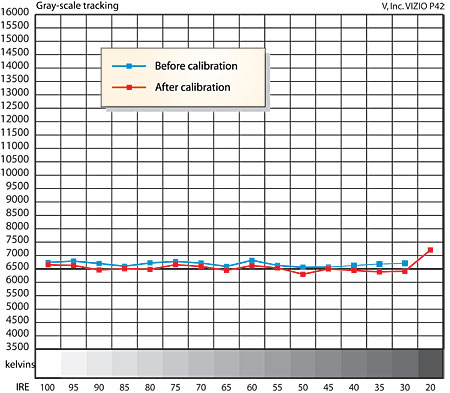VIZIO P42HDTV Plasma Testing and Calibration
Out of the box, my sample of the VIZIO plasma measured very close to the correct D6500. But it was a little minus red across the full range and plus green from 20IRE to about 65IRE. I was actually quite impressed by the picture at this point, but I nevertheless proceeded with a full calibration.

That proved to be a mistake, as the picture I ended up with after calibration, while technically closer to correct, actually did not look quite as good as it had before. If VIZIO consciously decided that a few minor deviations from a technically ideal setup produced a better image on this budget plasma, I can't say that I disagree with them. I have no way of knowing if the deviations were deliberate, of course, but if I read Joel's reaction to his sample correctly—and I have not seen his set—we both had similar positive feelings towards different samples of the P42HDTV out of the box.
The calibration I did perform proved extremely difficult. First of all, my sample did not want to go into the service menu without multiple tries—sometimes as many as 50 or 60! VIZIO suspects that my sample was defective at least in this respect, as it should be easy to access the service menu. To make matters worse, the adjustment menu covered the part of the screen needed to take readings. I had to make a change, exit the menu, take a reading, re-enter the menu (with the same tedious problems as before), and so on until I was finished. It took about three times longer than usual to complete the calibration. And the color temperature adjustment controls were also not only annoyingly interactive, but the results shifted noticeably when I exited the service mode.
The final calibration result is shown in the After curve. As noted already, I thought the picture had actually looked better before. And when I returned the service-level color temperature adjustments to the factory settings in an attempt to restore things to their original state, the set would no longer display black levels below 10IRE!
Our recommendation? This is a good-looking plasma out of the box, though you should still attend to proper adjustment of the video controls in the user menu—as you should with all sets. Calibrating the color temperature at the service menu level is difficult and not necessarily productive.
The color points were respectable. Red was actually quite close to the correct location (for NTSC). Green and blue were both a bit too saturated—common in digital displays.
The VIZIO's overscan was higher than I like to see, ranging from 3.5% to as high as 5.5% depending on the source (HDMI and component were both checked) and resolution.
With the HDMI input, the resolution on multibursts held up well to 37.1MHz at 720p, though the response was down a bit in level at that frequency and the burst pattern revealed a little unevenness there. In 1080i, the response was visible at both 18.5MHz and 37.1MHz, but appeared to be down in level slightly at both frequencies. With 480i/p the response appeared reasonably flat up to the required 6.75MHz/13.5MHz requirements for program material at those resolutions. The color burst response, while not (as usual) quite as extended as the luminance, indicated no problems likely to be evident in normal viewing.
The peak contrast ratio usually compares the peak 100IRE white level of a display using a full screen white field with a full screen video black. But because of their power supply characteristics, the light output of plasma displays is considerably higher with a 100IRE window pattern than with a 100IRE full white field. With the contrast control set for the maximum usable light output, I measured a white window peak contrast of 1260:1 (71.8 foot-Lamberts 100IRE white window/0.057fL video black). The full white field measurement was 496:1 (28.3 peak white/0.057 video black). All readings were made off the screen with Minolta LS-100 light meter.
The video processing (scaling and deinterlacing) of the VIZIO was, as JB notes, respectable, but my sample did not appear to do quite as well as his. On the HQV Benchmark disc it passed the first Jaggies test but didn't quite pass the second. There were subtle artifacts in the brick building behind the waving flag, but the flag itself was handled fairly well. It failed the difficult racetrack bleacher test. On the Faroudja test disc, it passed the test for unflagged 3:2 pulldown and performed well on the mixed content (scrolling video over film and film over video).—TJN













































